So you want to build a PC! Congratulations! We'd love to help you in any way that we can. So let's go over the main components that make up the majority of PC builds, what they do and their relationship to each other.
Before you think about anything else, you need to be aware of your budget. With your budget, you can now decide what’s most important to you and what you want to get the most out of your PC. With a budget in mind, you may have to compromise on a few things, such as a different case or a graphics card. It’s worth researching the prices of these components in order to maximise the return on your investment. You may decide that more processing power is worth the sacrifice of the RGB lights, which is known as a sleeper PC. Some people believe the RBG lighting is the gaming PC look, and people will budget around what is important to them.
Your budget also has to consider what purpose you are building this PC for. You may have absolutely set your heart on one particular graphics card or case and build everything else around it. Or perhaps it’s the PC’s purpose you need to think about: do you need it for casual gaming? High-end rendering or editing? Any manner of these tasks will require thought of what components will be needed to handle them. For example, people who build a PC for gaming will want to put most of their thought into what graphics card to use, whereas those wanting a PC for production will need to consider what processor has enough power for the job. Let’s look at these components in more detail:
Processor
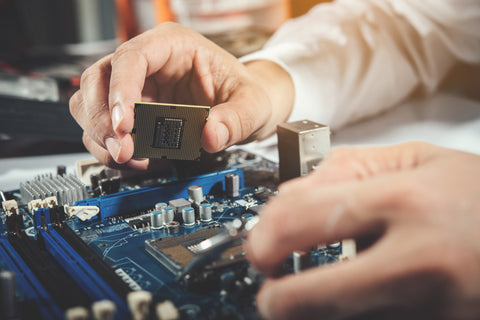
If we consider a computer a bit like a body, then the processor is definitely the brain. Your processor, also known as a CPU, handles how fast your computer can process information. In today’s market there are two main choices of processor: AMD or Intel. There are pros and cons for both, neither of them is significantly better than the other, so really this comes down to your preference and which one catches your eye more. If we were to break it down fairly simply, Intel processors are better geared towards gaming, whereas AMD ones are better suited for the production side, notably the thread ripper series.
Motherboard

If the processor is the brain, the motherboard could definitely be likened to the computer’s heart. The motherboard’s form factor (its dimensions, the power supply it requires and number of mounting holes it had) is highly dependent on the CPU, as some motherboards are incompatible with certain processors, so it’s really important to do your research here. Even things such as the size of your case must be considered and if your motherboard’s dimensions will fit inside. Equally, the motherboard’s ports are just as important: has it got a 16xPCiE connector for the high-end graphics cards? Has it got PiCE4 for m.2 speed reading? Has it got Pcie5 for your particular graphics card? Does it have Wi-Fi built in? Does it support USC-C? Experts in the field can help here if you’re unsure.
Case
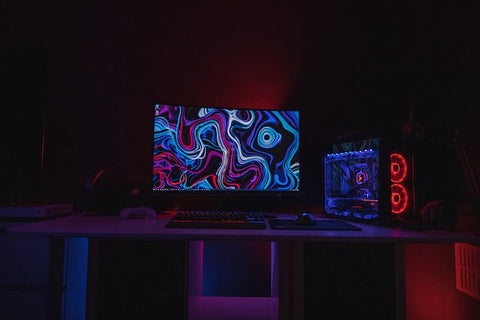
The case is the outside, how you want your PC to look. For a lot of people, this is one of the most important components for them, and may compromise on certain things in order to build their PC in the case of their choice. There are thousands of options on the market that come in all different sizes, shapes and colours, so there is surely a case out there for you. Most computer components are made to fit inside most cases on the market, aside from the aforementioned motherboard which requires a but of research to ensure that it is compatible. If you’re set on a certain motherboard, then you will have to buy a case that will fit it. As I said, there are thousands of options so unless you are dead set on one certain case, then it’s relatively easy to find a case and a motherboard match. When purchasing just a case, often retailers will advise you to check the form factor of the motherboard you wish to install in it. Once you’re happy with the case, then really it’s open season! You can have RGB lights that are vivid and bright, or ones that are subtle, so pick the customisation that’s right for you.
RAM
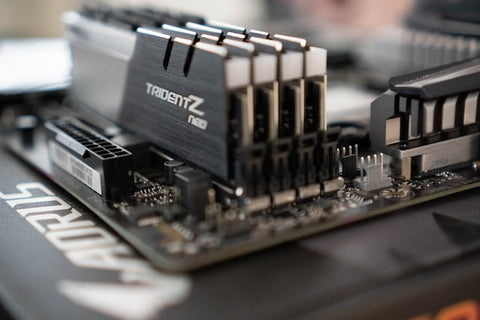
RAM stands for Random Access Memory. There is a lot of choice for your RAM, and really it comes down to how much space you want it to have. They come in sizes from 8GB all the way up to 128GB, with speeds from 2666 to 4800. The RAM size will depend on your motherboard and how many slots it has to accommodate the RAM sticks. Most motherboards only support DDR4 RAM but with some of the newer ones they can support DDR5 RAM. The higher the speed of the RAM, the faster your computer will be. The size you require will depend on what you are building your PC for. Most builds will have 64GB, 3200MHz DDR4 RAM split between two channels, equalling two sticks of 8GB RAM. We are always happy to help if you feel you might need more or less than this, and we are happy to help you!
CPU cooler

Processors get hot. Like, really hot. It’s important to keep them cool to prevent them from frying. Most CPUs come with a stock cooler as standard but you might have considered getting something a little flashier or better to avoid bottlenecking your build with the temperature of the components. Two fan all-in-one coolers do tend to work really well in this instance, which gives you the cooling performance of the more expensive water coolers without the struggle of maintaining it. Any extra cooling will benefit your build massively to avoid the bottlenecking I mentioned above. Water cooling can get slightly complicated as it requires a bit of time and effort to maintain it. However, even a single fan water cooler is better than the stock water cooler, and if you want to get really technical, there is a process known as custom water cooling wherein your CPU and graphics card are water cooled, but this requires a bit of time and effort from you to ensure the water doesn’t break through its O-ring seals due to general wear and tear and make the water impure, causing a rise in temperature.
Graphics Card
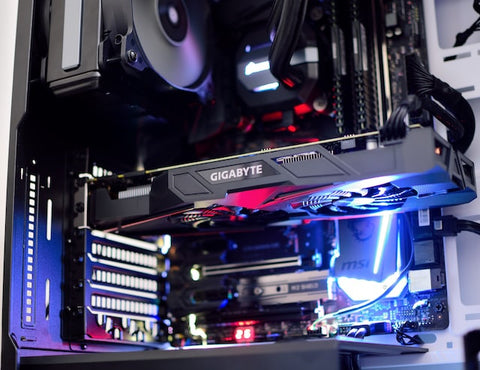
Some CPUs come installed with integrated graphics, but more often than not, graphics cards sold separately are generally the better choice if your budget allows for it. If you’re going down the gaming route, then you will probably want to invest in a graphics card. If you’re building a PC for light gaming or for work, then your PC may only need integrated graphics. Even if your PC doesn’t have integrated graphics, there are still several affordable options on the marketplace. We don’t recommend purchasing graphics cards second hand as there will likely be no evidence just how much the graphics card was worked before it came to you. We wrote a blog about our current favourite graphics cards available right now for gaming, and the 3080 came out on top in terms of performance and affordability. A 3070 would also be perfectly acceptable. For more intensive tasks such as production, the 3090ti is pricey, but will get the job done faster than any of the other cards. We also wrote about the rumours of new graphics cards that may be announced later this year, the 4090 and 4090ti., which you can read here.
Power supply
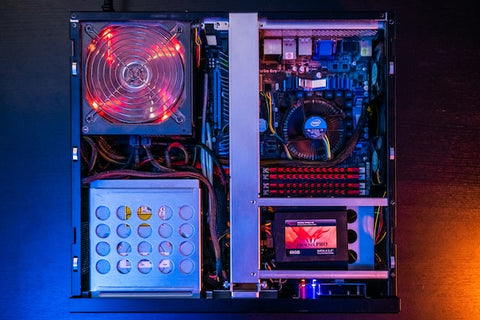
Basically a huge battery, the power supply will channel electric from the outlet to each component, ensuring no threat of overheating or frying. We advise sticking to trusted brands for your power supply as they have a track record and are trusted by millions of users across the globe. In our builds we tend to use brands such as Corsair or Seasonic due to their reputation and reliability. They also tend to last longer too. When buying your power supply, you need to calculate the total running wattage of your system: a top end graphics card and CPU would mean a power supply with a wattage of around 1000w or even 1200w. Often, retailers will suggest what wattage their graphics cards will require, which can be a great help when designing your build: bear in mind you will need to account for the wattage of the motherboard and CPU on top. It’s ideal to leave a bit extra when calculating your wattage so you’re not limiting your system or its performance when supplying it with power.
Operating system (OS)
Most PCs require an operating system, or OS, in order for it to function and for you to use it. The most common choice is Windows, and it’s definitely the most user friendly: unless advertised, all of our builds come with Windows 10 as standard, with a free upgrade to Windows 11. For the more technical among us, you can go the route of command interfaces such as Linux if you would rather not use an OS.
Accessories
Now it’s all built, why don’t we make it even flashier? You may want to add a few extras such as more fans to maximise your cooling, or some strimmer cables rather than the plain old power supply cables to really make it pop. Like so many things in this world, they’re not necessarily needed, but they make our purchase feel personalised to us. In some builds there are even options to add a little mascot figure in there!
Whatever you choose for your next build, we are always here to help you choose the one that’s right for you and your needs. You design it, and we’ll build it.







